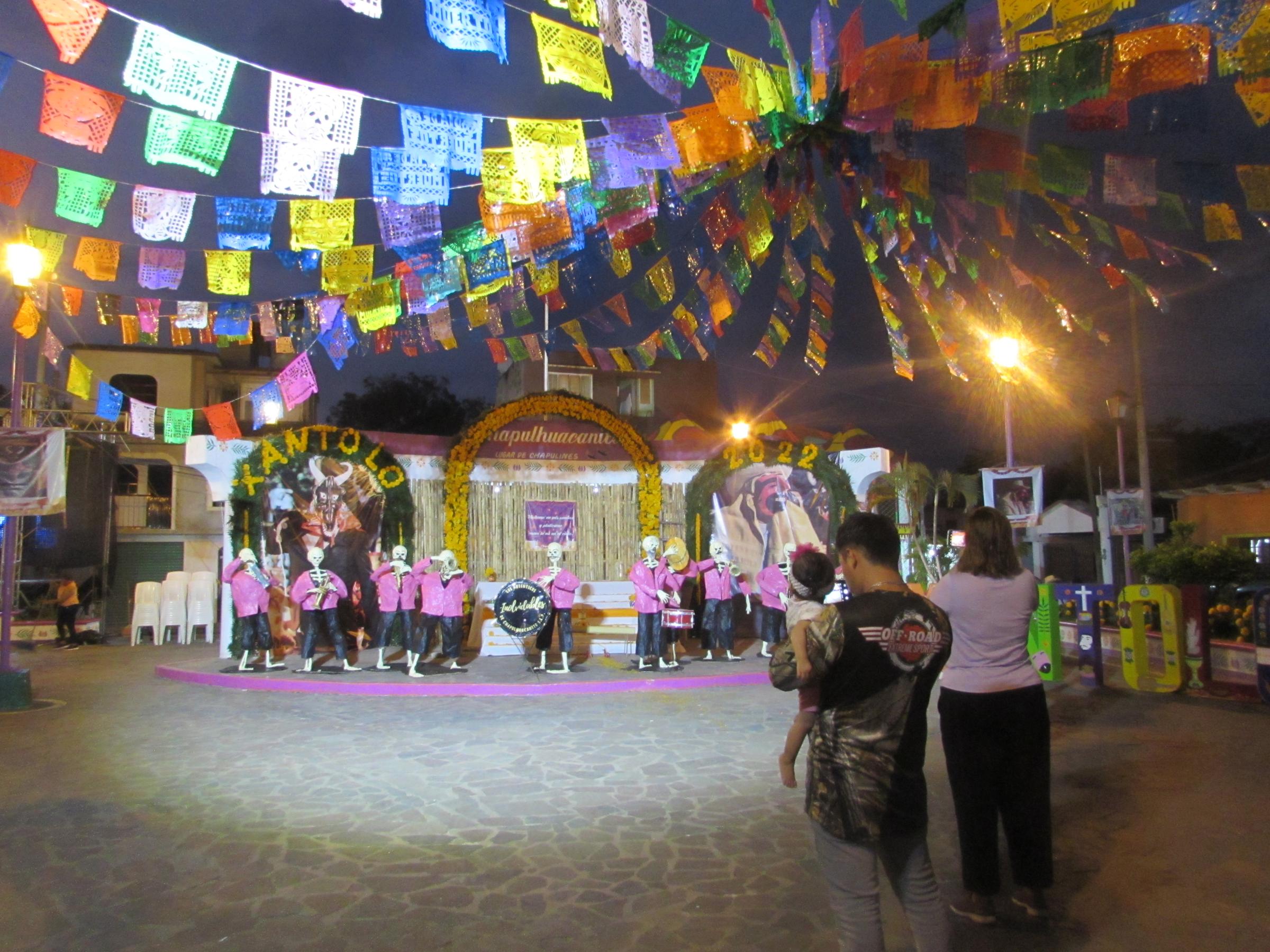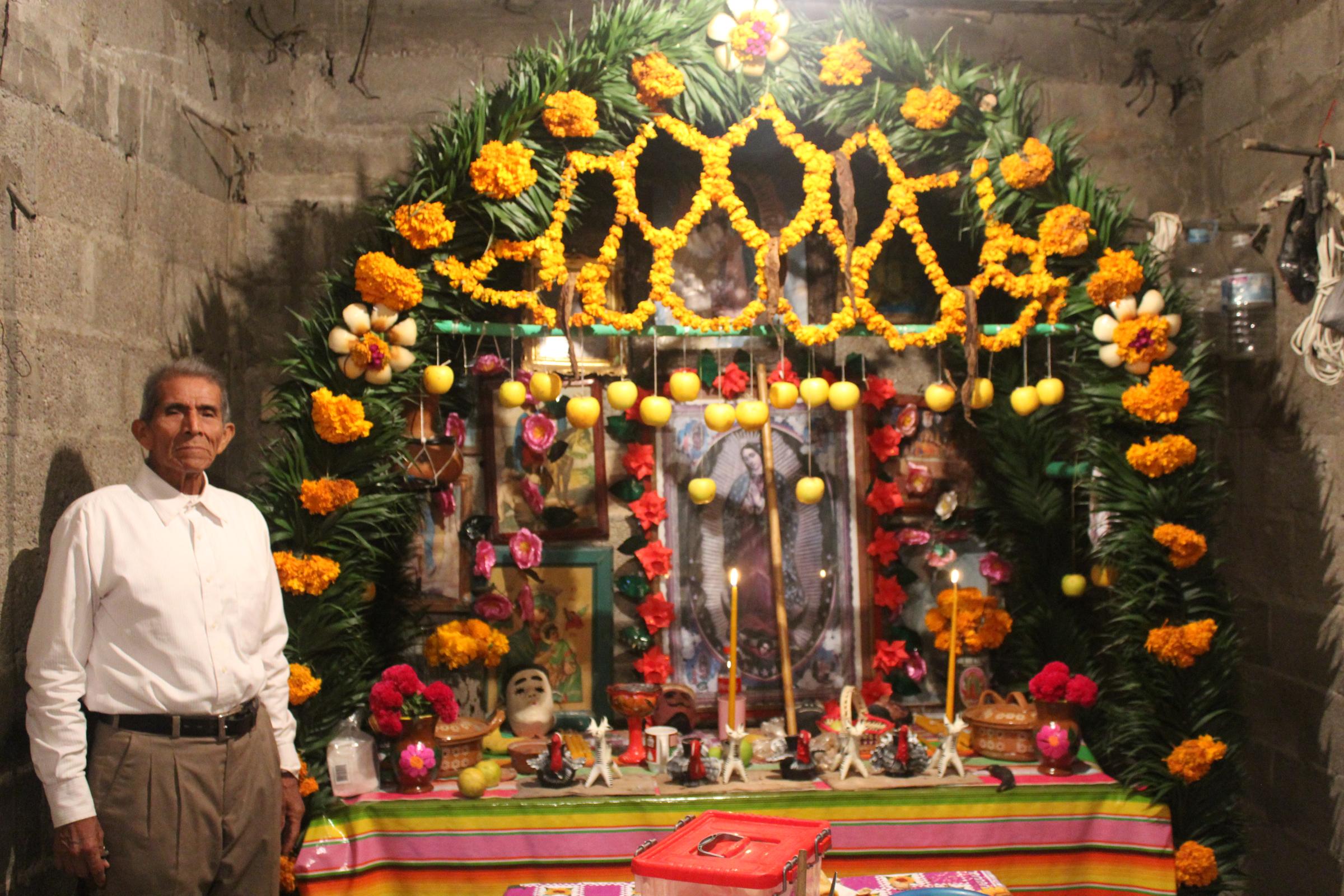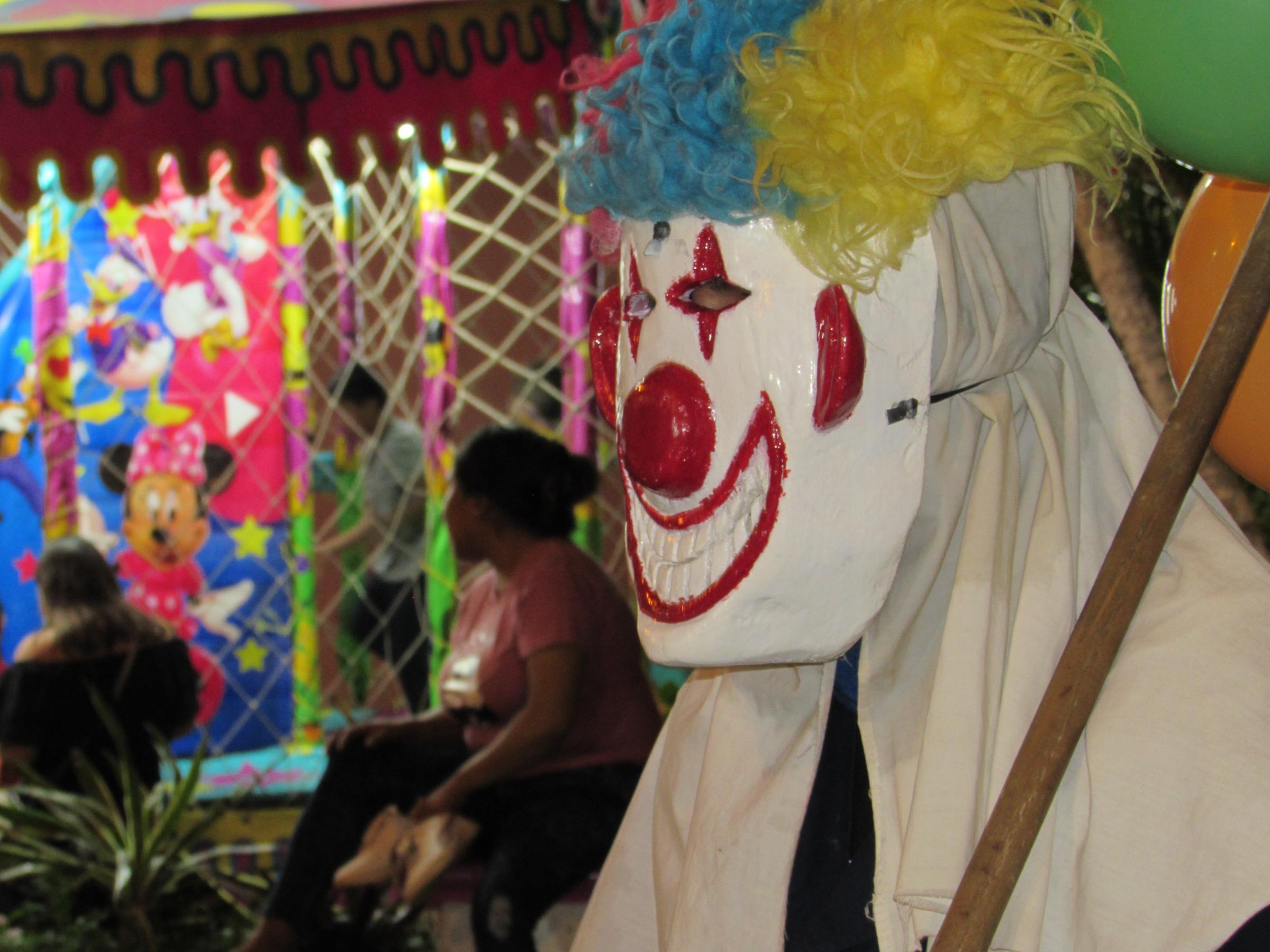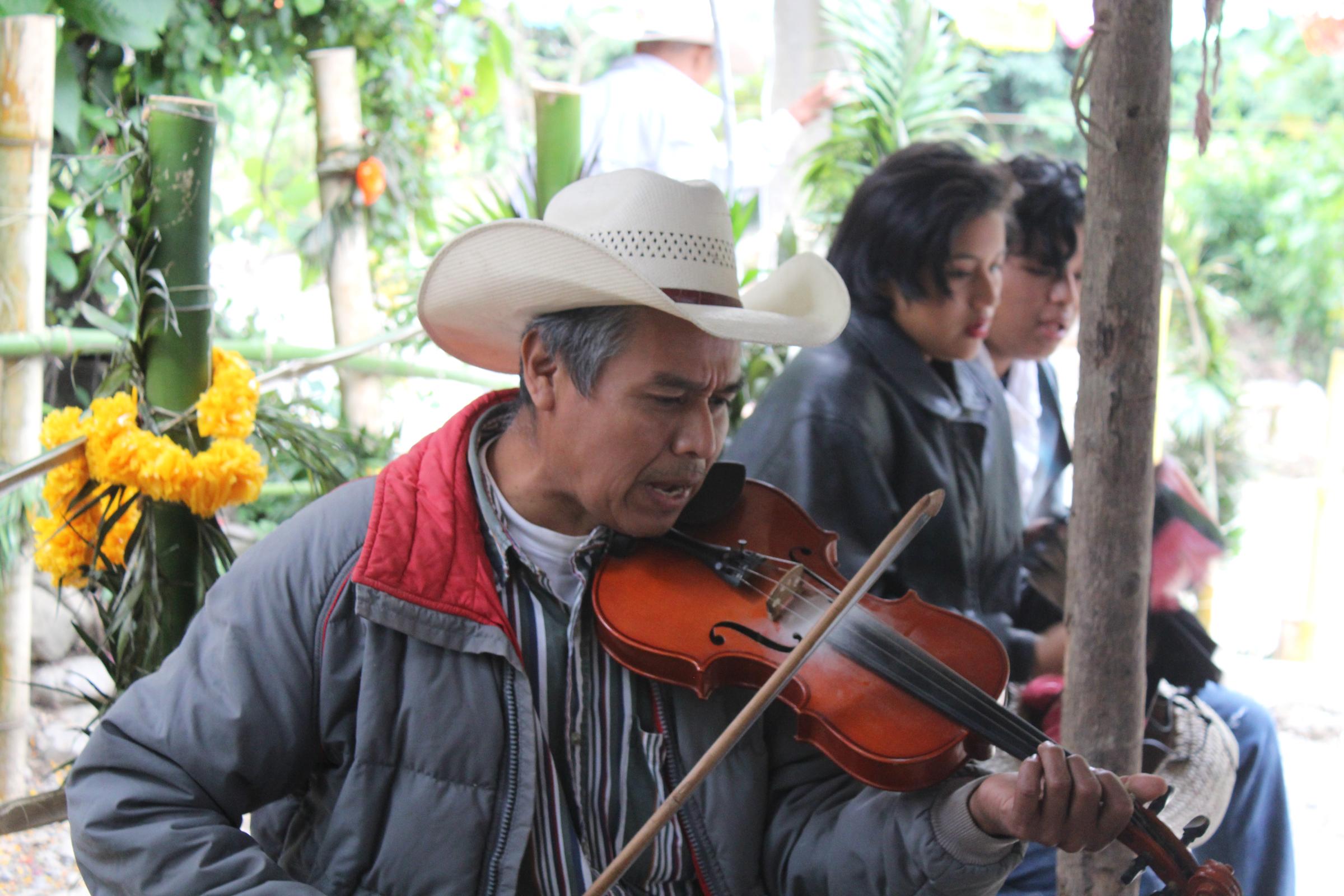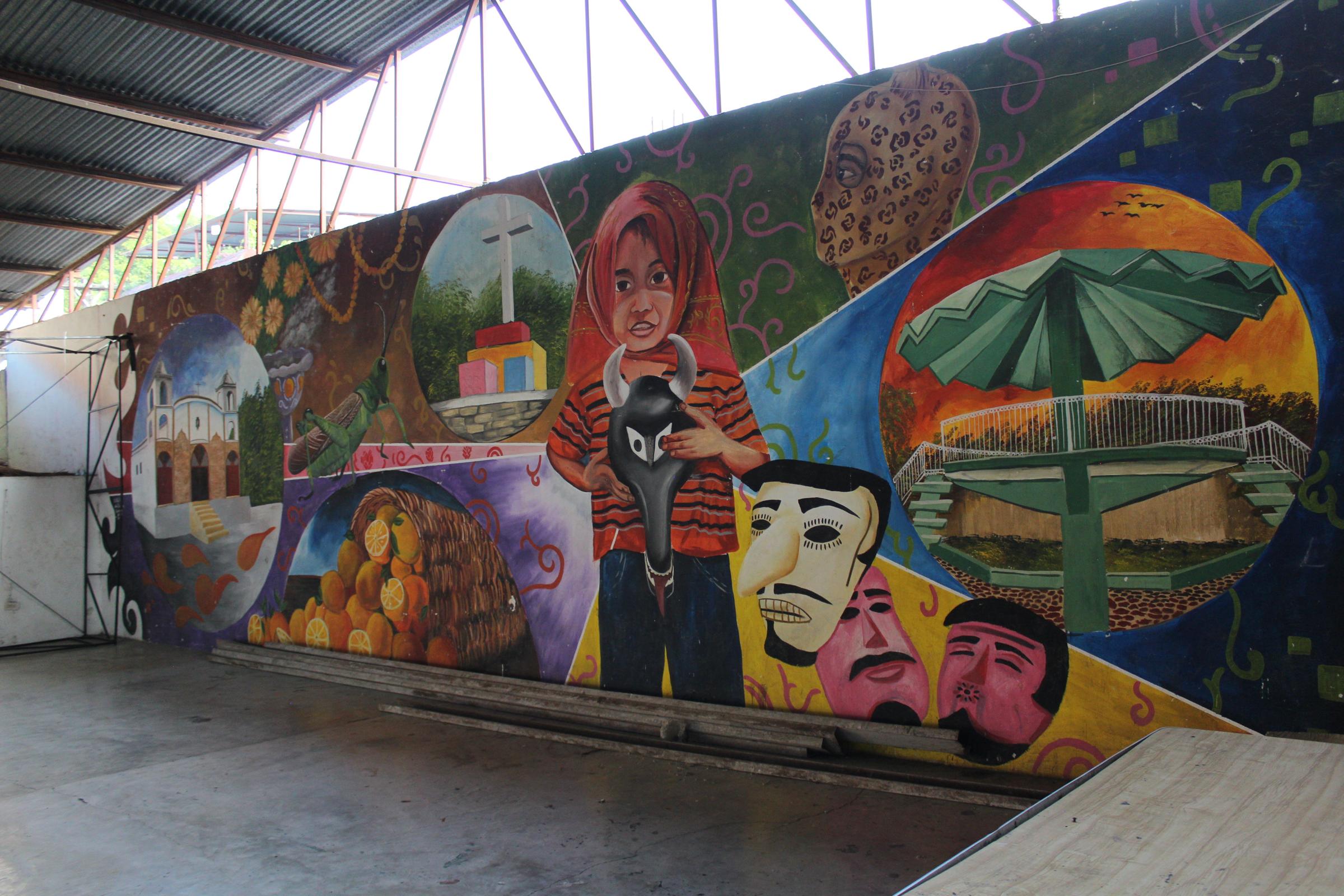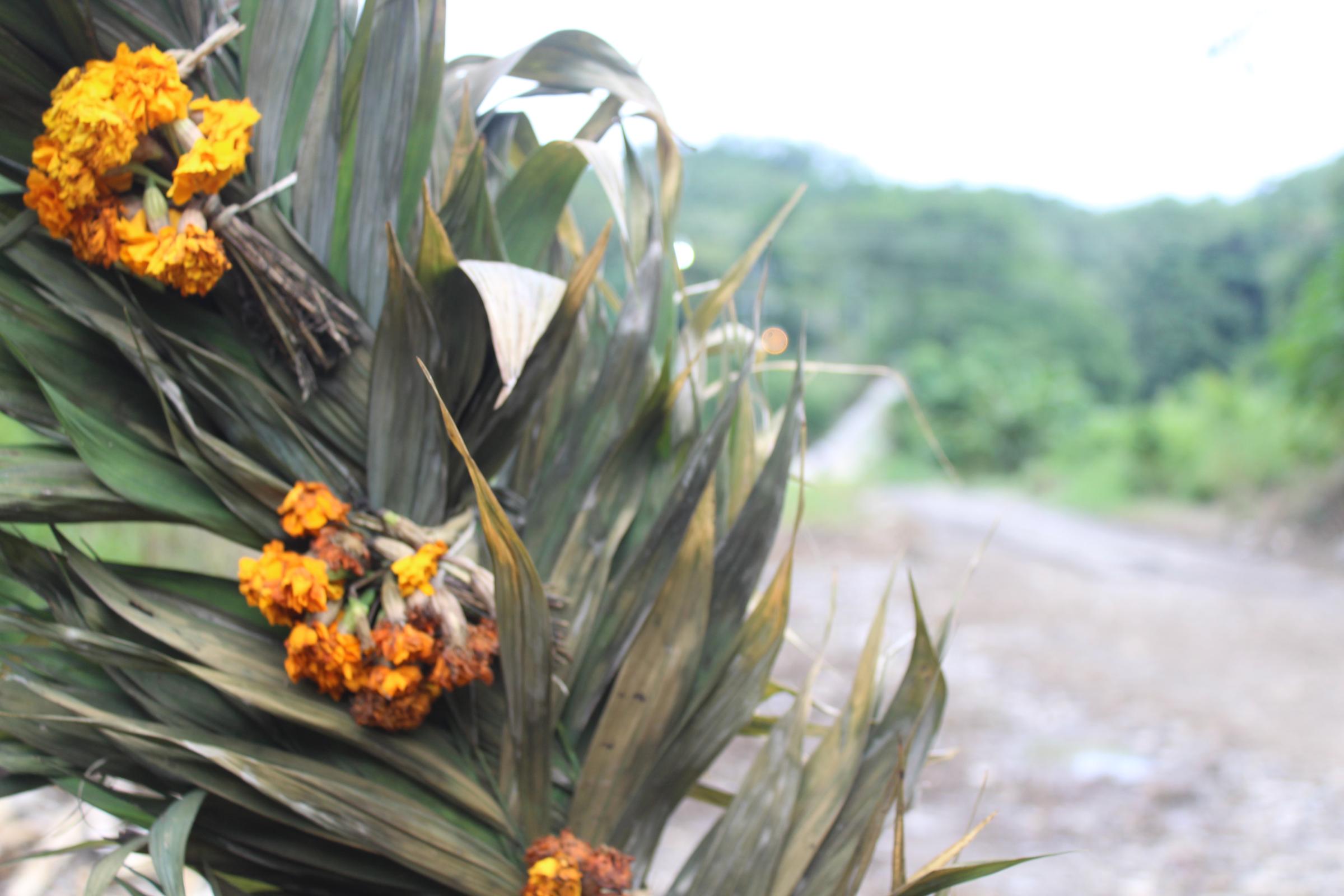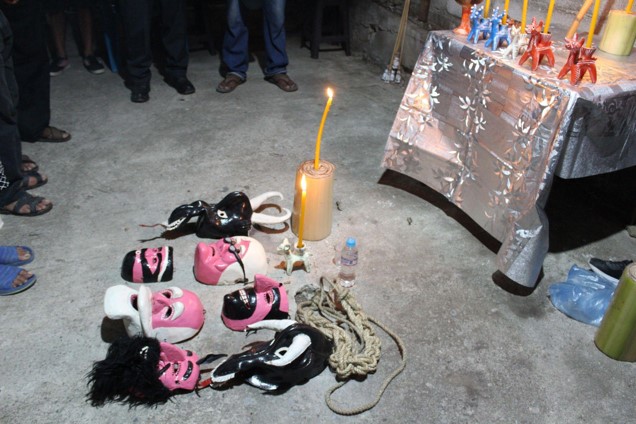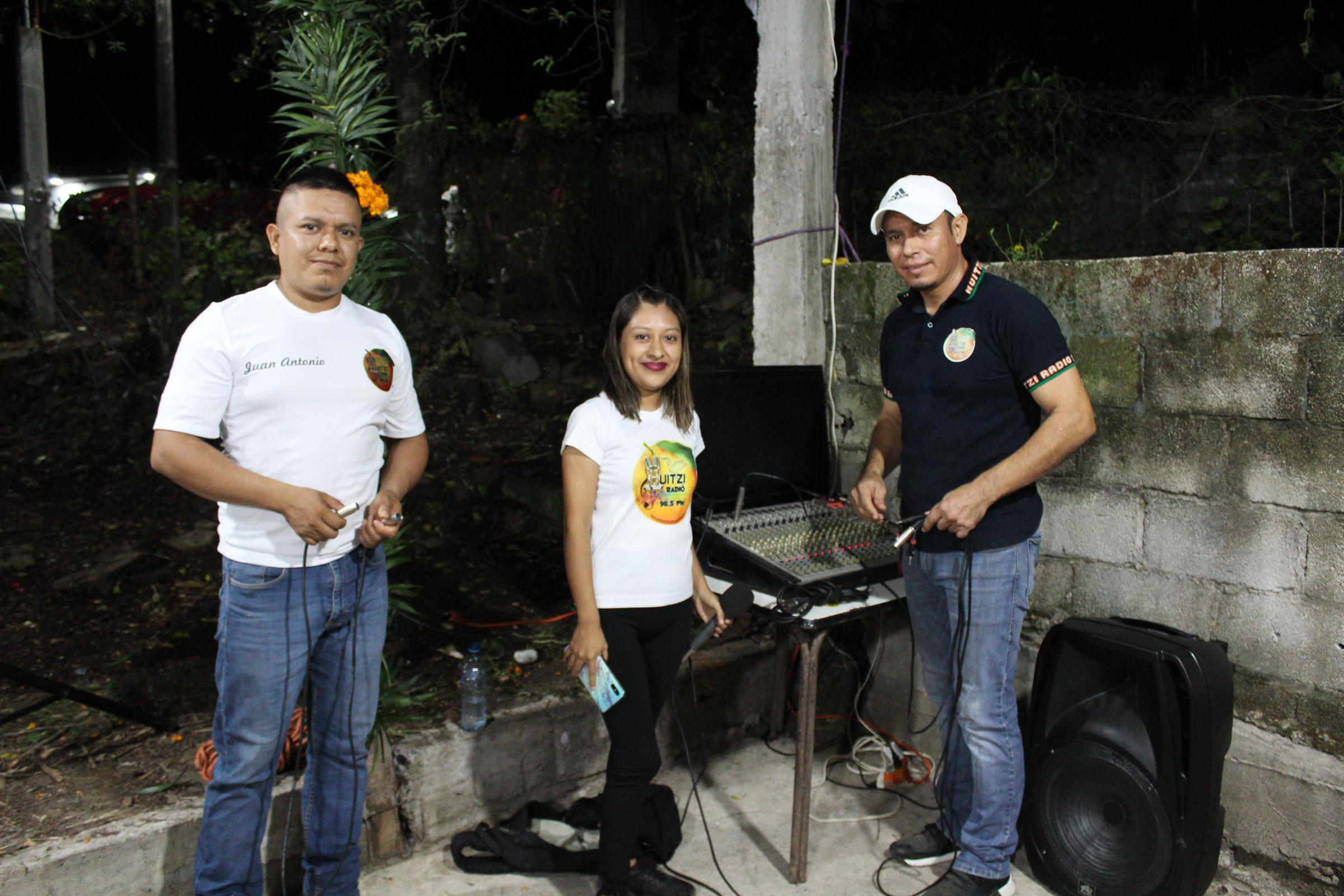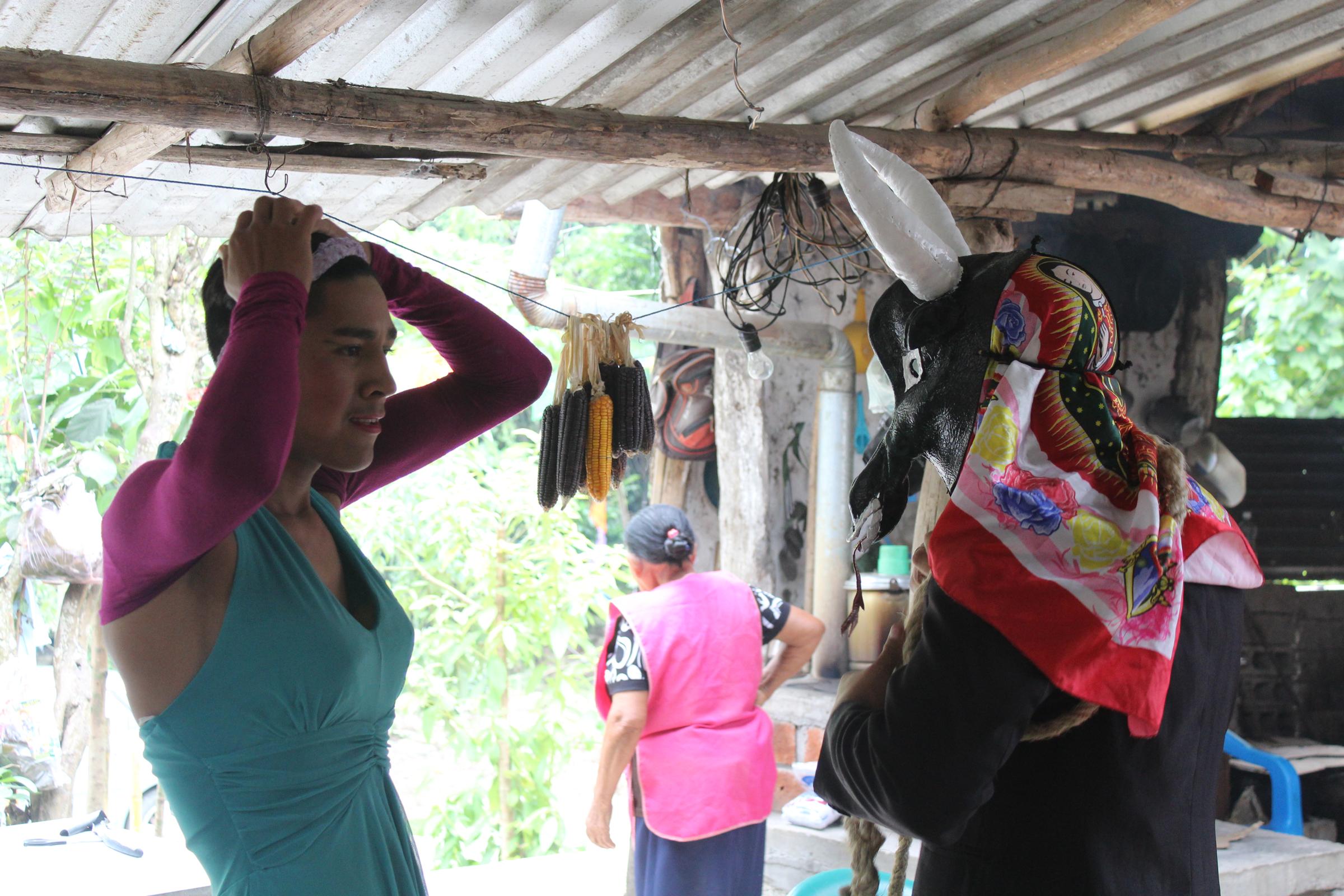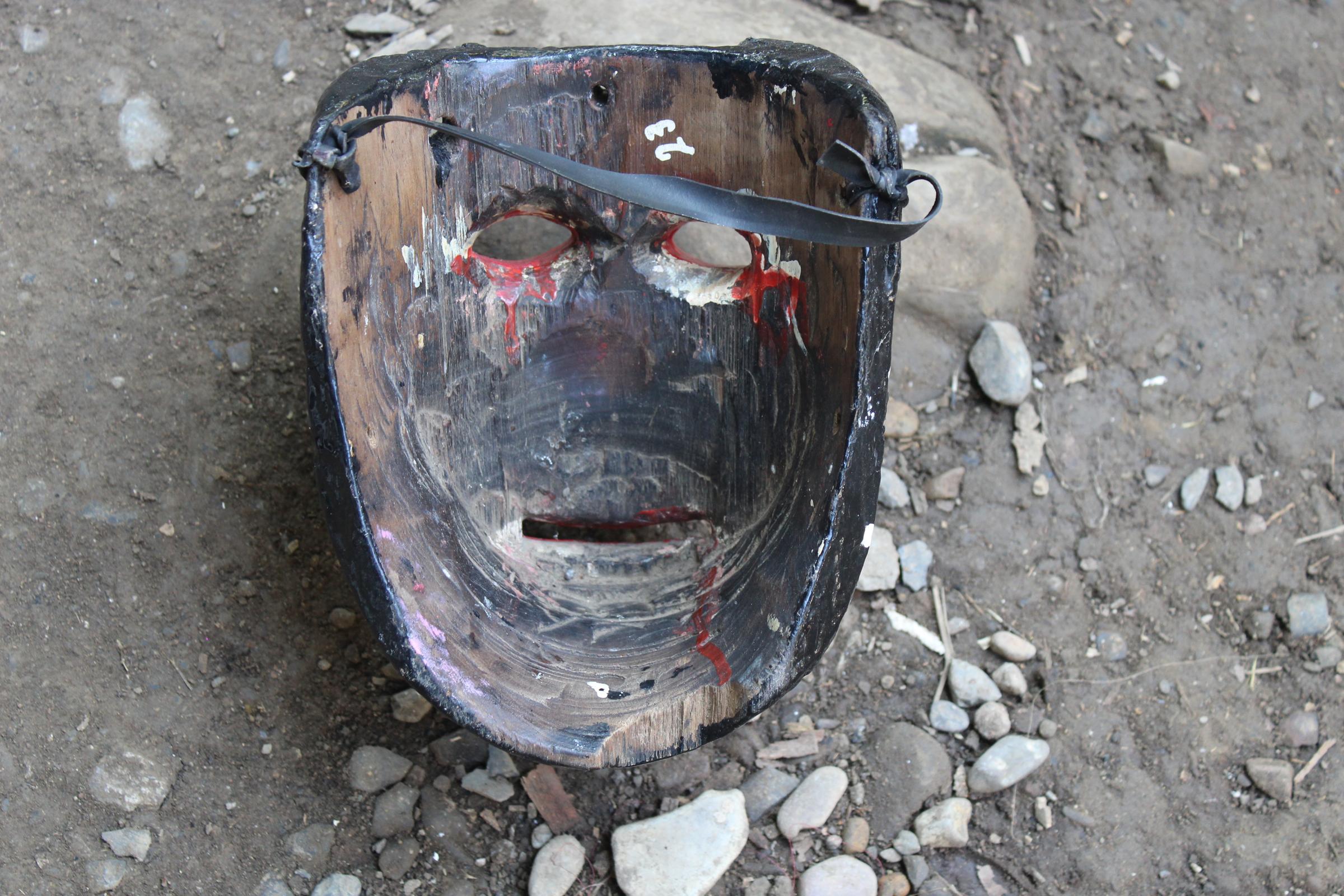Photographing a ritual process: an approach to the agency of Xantolo masks in the Huasteca Potosina.
- Pablo Uriel Mancilla Reyna
- ― see biodata
Photographing a ritual process: an approach to the agency of Xantolo masks in the Huasteca Potosina.
Receipt: March 24, 2024
Acceptance: April 30, 2024
Abstract
This photo essay shows the agency of the masks used during the festival of Xantolo or Todos Santos in Chapulhuacanito, Tamazunchale, s.l.p. It focuses on making visible the relationships and ritual practices that exist among the people who are part of the group of disguised people in the neighborhood of San José, the masks are placed as the axis, which materialize the dead during their passage in the world of the living. Arranged as a process, the photographs make visible the capacity of the masks to influence people in the ritual context. The photographic work presented was made from 2019 to 2023.
Keywords: Huasteca Potosina, masks, nahuas, Xantolo
photographing a ritual process: an approach to the agency of the xantolo masks in the huasteca potosina
This photo essay shows the agency of the masks used during the Xantolo or All Saints celebration in the village of Chapulhuacanito, Tamazunchale, in San Luis Potosí. Homing in on the masks, which allow the dead to materialize during their visit to the world of the living, it draws attention to the relations and ritual practices among members of the costumed group of the San José neighborhood. Laid out as a process, the photographs -taken between 2019 and 2023- bring into focus the masks' capacity to influence people in the context of the ritual.
Keywords: Huasteca Potosina, Nahua, masks, Xantolo.
Introduction
This essay is based on the questions: how to make visible the relationship between people and objects, how to bring to the visual the analysis of the concept of agency in the work of Alfred Gell (2016), using as a concrete case the rituality of the Xantolo masks in the community of Chapulhuacanito, in the Huasteca Potosina. This is a reflection that arises after the time of my fieldwork; when reviewing the photographs I could realize the way in which I was focusing the camera lens and where I had to pay attention to analyze the social relations between the masks and the members of the costumed group of the San José neighborhood.
This paper intends to think of the role of the camera and photography in fieldwork as an enhancer of analysis. As Elisenda Ardèvol points out, "perhaps, after all, the camera is an instrument that allows us to broaden our vision and helps us to see more than with our naked eyes" (1994: 10). It is also considered that the presence and use of the camera can modify the relationships in the environment in which one interacts, "modifying the ethnographic experience, the researcher's relationship with the field, the interaction with the participants, and the construction and analysis of data" (1998: 225).
By focusing the photographic camera on the relationships that develop between the people who participate in the San José costumed group and the Xantolo masks, a dialogue between visual anthropology and the concept of agency is possible. The relationship between people and objects has been worked from different perspectives, such as Bruno Latour's Red actor theory (2008), and the text by Art and agency by Alfred Gell (2016). The latter author's approaches will allow me to generate a supporting framework to show the relationship and inference of masks in a ritual context.
According to Gell: "Agency can be attributed to those persons and things that bring about causal sequences of a particular kind, that is, events caused by mental acts, rather than simple concatenation of physical events" (2016: 48). If we start from this approach, in the present study we can consider agency as the implications produced by the relationships that occur between the masks and the participants of the ritual process.
In order to follow the thread of this problem, it is necessary to make an ethnographic journey focused on the moments in which the relationship between people and masks is visualized. This process is linked to the ritual system of Xantolo, so that this essay seeks to explain the social organization around the masks used on that date. Subsequently, I will develop each of the ritual moments: 1) the lowering of the masks as an encounter with them, 2) the Xantolo as the highest moment of rituality and interaction with the masks, and 3) the uncovering, moment in which the participants of the costumed groups take off the masks to be kept until the following year. Each of these has a very strong relevance for the costumed group, and in both the ritual and the party the masks project their agency on each of the participants. The photographs seek to show this agency.
Notes on Chapulhuacanito
The Huasteca is a region that includes part of the states of San Luis Potosí, Veracruz, Hidalgo, Tamaulipas, Querétaro and Puebla. It is recognized by shared natural and cultural traits, although it is complex and diverse in the internal practices of each group, locality or community. One of the festivities typical of the region is the Xantolo. In the south of the Huasteca Potosina, in the delegation of Chapulhuacanito, belonging to the municipality of Tamazunchale, this festivity is of great relevance (see image 1).
The word Xantolo owes its origin to Latin SanctorumIt was because of the way in which the inhabitants understood the word that it was transformed. This ritual, mostly celebrated among the Nahua and Tének groups, responds to the Mesoamerican agricultural ritual cycle based on the rainy and dry seasons, sustained mainly on the cultivation of corn, around which a series of beliefs and practices are developed (López Austin, 1994: 12). As defined by Amparo Sevilla, the Xantolo "are days in which a sacred time is opened for the celebration of life and death" (2002: 6).
Within the agricultural calendar, Xantolo corresponds to the season in which the harvest has been raised and there are a series of activities related to corn and other crops, within which the offering to the deceased and the deities found in the underworld is prioritized. In Chapulhuacanito, a community of Nahua origin, Xantolo is experienced both as a domestic ritual (see image 2) and as a festival that involves the whole town.
This work highlights the context in which the Xantolo takes place; we can appreciate a rituality deeply rooted in the cult of the dead, which is expressed in domestic practices and in the relationship with the masks that are used during the holidays. It is also a community that is part of the tourism dynamics that has developed in recent years in the Huasteca Potosina, and that reconfigures the concept of "tradition" (see image 3) and the way in which ritual practices are expressed.
The social organization around masks
Chapulhuacanito, with a population of 3,212 (inegiThe district is divided into eleven neighborhoods that currently make up the delegation. However, the ritual organization is centered on the three main neighborhoods: the neighborhood of La Cruz, the neighborhood of San José and the neighborhood of Pixtello. These neighborhoods, along with the center, are the founders of the community and are significant, as each has a number of masks (approximately 40 in each neighborhood) that are used for Xantolo. Each barrio has a group of costumed and traditional charges in charge of the care of the masks. These charges consist of a first and second empresario, who are in charge of making a reed house to store the masks. In addition, they are in charge of organizing the food for the descent of the masks and the days of the Xantolo festival.
Usually, being the first businessman is a position that many people do not want to accept, because it involves a significant investment of resources. "Many don't want to be businessmen anymore, because when you have to organize the bajadas and the Xantolo, you end up putting up your own money," commented Cecilio, a former businessman in the San José neighborhood.
The entrepreneurs receive support from people in the neighborhood or from the participants of the costumed groups themselves. According to the entrepreneurs, the support is crucial to carry out the festival, but also the support and costs have changed. For this reason, they also need economic support from the delegation. In this regard, Raquel (entrepreneur from 2017 to 2019 from the San José neighborhood) highlights:
What costs the most during the days of the festival is paying the trio of Son Huasteco, that's why we ask the delegation for support. Before, the trios charged very little, but now they charge more, and sometimes the money is not enough. In addition, we have to pay the trio for the uncovering dance (see image 4).
The fact of providing support has caused the participants of the costumed groups to feel a sense of belonging to the neighborhood in which they participate. In addition to the support in resources to carry out both the rituals of the masks and the Xantolo festival, the constancy of the participants in the costumed groups is due to the commitment assumed with the masks. According to the businessmen who have preserved the knowledge of the tradition, when they put on one of the sahumada masks, they have to disguise themselves for seven years. This number is associated with the underworld, as pointed out by Lourdes Baez (2008) in her studies of Nahua culture.
The dynamics observed between neighborhoods is crossed by a process of ritual conflict, in which there is a medullar moment to later reach a denouement (Turner, 2002). This is visualized and resolved during the days of Xantolo. An example is the conflict between the neighborhood of La Cruz and the neighborhood of San José, originated by the loss of the first devil mask (see image 5). Apparently it was donated to the San José barrio but, according to people say, it was lost by the barrio de la Cruz and since then the members of the barrio de la Cruz have kept it. The conflict led to a competition between the neighborhoods, demonstrating which of the two performs the rituals more attached to what tradition dictates.
The lowering of the masks
The ritual cycle that comprises the Xantolo begins on June 24 (St. John's Day), when the seed of the cempasúchil flower that was removed from the arch the previous year is watered (see image 6). After that comes the arrival of the dead to the world of the living, on September 29, day of Saint Michael the Archangel, who is in charge of opening the doors of the underworld to allow the passage of the souls. This date for the Nahua group is very significant, since the first offering to the dead is given, in which tamales and chocolate are made.
This day is expected in every household, except in those that are Christians and Jehovah's Witnesses, since these religions consider these practices as devil worship and also link them to the use of firewater. The testimony of Josué (former participant) is illustrative in this regard: "I used to go to the masks and dress up, but I don't do it anymore because I changed my religion. Besides, there is always aguardiente at the masquerades and I don't want to drink it anymore".
Days before the first descent of masks (September 29), the women of each family go out to look for banana leaves, to grind corn to prepare the dough for the tamales and to buy chicken for the stew they will use. Each family prepares an offering in their home: they place a candle, tamales, coffee, take out the incense and put copal powder on the embers that they take from the kitchen stove.
The ritual practice as a whole takes place in each of the main neighborhoods. The participants of the costumed groups gather at the house of the businessman to help in the preparations for the lowering of masks.
When the businessman wakes up, he sweeps the reed house, lights a candle and leaves a bottle of aguardiente. Around 11:00 a.m. the participants begin to arrive, help clean the place, arrange chairs and make an arch with palmilla and cempasúchil flowers. The businessman's wife is usually in charge of organizing the making of the tamales, which involves the participation of other women to prepare the chili for the meat, cook the meat, prepare the dough and spread it on the banana leaves (see image 7).
Usually, the women work most of the day on this task, while the members of the costumed groups prepare the place for the lowering of the masks (see image 8).
The time to welcome the animas is around 7:00 p.m. on the evening of September 29; prior to this, the businessmen should have already invited the former businessmen to attend the descent.
In this first descent, only four or seven main masks are lowered: the standing horned devil, the crouching horned devil, the older cole, the grandfather and the grandmother (see image 9).
In the reed house a ladder is used to reach a false ceiling where the masks are located. One of the participants is asked to climb up to begin to lower them, these are received by the businessmen and accompanied with incense, which the businessman blows in order to fill the mask with copal smoke. At that moment the deceased materialize in the masks and to prove it is necessary that they touch the floor. Afterwards, the past and present businessmen, as well as other assistants who are close by, spray aguardiente on them, and some people even come close to spray it in the mouths of the masks.
Afterwards, these masks are placed on a table where all the attendees pass by to smoke them from right to left. At that moment the masks begin to modify the behavior of the people and create another type of relationships around them. The assistants become serious, nostalgia arrives when seeing the masks that had been kept for a year. This refers to what Gell posited, when he talks about artifacts as social agents, "not because it is intended to enact a kind of mysticism of material culture, but by objectification in artifact form is how agency is manifested and realized" (2016: 56). In this sense, agency is manifested in the change in behavior that participants begin to engage in.
The second "bajada" takes place in mid-October, the date may vary and is decided by the members of the costumed groups. For this bajada, in the words of the people, "the thing is bigger". The number of people that the entrepreneurs invite is larger than the first one. The arrangement is more elaborate, since all the masks are lowered and the altar will remain assembled in this way for the days of Xantolo (see images 10 and 11).
The relationship of the masks with the members of the costumed group expands because there are more masks and, then, it is common for them to start looking for the mask they wore the previous year. In this regard, Gordo commented:
Everyone knows that the mask with the mustache and beard is my mask. I've been holding it for several years now, wearing it, and not just anyone can wear it, because the mask also takes on something of my personality.
Referring to the above, this is how the participants of the costumed groups identify the mask with which they want to participate during the Xantolo festival.
El Xantolo: the time to go out and dance
On one occasion I was told that the costumed people used to go out to dance in a different way. During the days of Xantolo from November 1 to 4, the first one to go out was the devil. People remember the thundering of his chirrión in the morning, in that way the devil announced the arrival of the costumed people. But it was not only about that, but also about the school that arrived later knocking on the door of the houses to warn that the deceased had arrived, that they came carrying their children and that they only asked to be allowed to dance a song and to give them something to continue on their way. The feeling of the people is that it no longer happens like that, that they have changed, that some things are no longer done and others they want to take up again following the advice of the old businessmen of how they have to be done.
The Xantolo "reflects a vision of the world in abundance, and is one of the festivals that is deeply related to the social life of the people in the most remarkable way" (Ruvalcaba, 2013: 277). In this community, the beginning of the Xantolo festival takes place on November 1 with the watering of a path of cempasúchil petals at three o'clock in the morning, and from there to sahumar to offer the food. These are days of coexistence and going to the cemetery. Raquel comments: "Here on November 1 and 2 it is customary to visit the family, to take tamales and also to make offerings to the house where they go".
During these days, a dynamic of coexistence is generated and the costumed groups immerse themselves in the relationship that each one seeks to establish with his or her mask. The participants of the costumed groups arrive at the entrepreneur's house to start configuring their character in the company of the others (see image 12). This is how each participant arrives with the clothes he/she is going to wear or with some material with which he/she intends to make his/her costume.
When the participants arrive at the businessman's house, they approach the altar of the masks and they smoke them. They begin the conviviality around the masks, they comment on their condition, if they are deteriorated, if something needs to be renovated; or on the contrary, how well cared for they are.
Before going out to dance, they wait for more people to gather, because if there are more, they can have a greater impact on the neighborhood and the community. While they wait, children between seven and 13 years of age always arrive, they are curious about the masks. Sometimes they come with their parents, other times they come by themselves, and in other cases they are not allowed to participate in a costumed group or even touch a mask. In this regard, Cecilio comments:
When the children come here, we think it is good that they come because we explain the tradition to them, but we also tell them that this is not a game. We make a game out of it, but it is not a game, because we are dealing with the dead, and that is something that requires a lot of respect. I tell them to treat the masks with respect because I don't want to know that they are going crazy and that I have to go dancing for them.
After everyone is ready, they go out to dance around the community. At this point, the masks go through the streets of the town being carried by the participants of the costumed group. At that moment the mask exerts force on the person wearing it. In the words of Óscar:
When I put on a mask I am not me. Rather, I leave my personality aside for a moment, to give way to the past, to the mask, because no matter how many disguises you put on, the mask has a personality of its own.
Other participants mentioned that the mask had a certain weight that they had to bear. Wearing masks always left them tired, but they only felt tired at the end, since during the moment they were wearing the mask this tiredness manifested itself as energy to continue dancing, energy that is given by the mask.
In Gordo's words:
When I wear a mask, I don't get tired. It's as if it gives me strength to follow him, and besides, wearing the mask allows me to make jokes or do things that I wouldn't do if I didn't wear the mask. Yes, it's true, the mask disinhibits, but I also think it's because when you put it on you're already another person.
Danger and cure
During the holidays, being in contact with masks is a situation that can generate danger. It is about going crazy, named as such to the evil that can cause the mask caused by the misuse or disrespect that can be given to it. When a person goes crazy the symptoms are manifested in not being able to sleep or constantly hearing the scream that the disguised people emit while dancing.
When a mask drives someone crazy, the entrepreneur becomes a healer. They are the only ones who can perform the healing process, which consists of scraping a mask from the inside and the dust that comes out of this scraping will be poured into aguardiente to be drunk by the person who is going crazy (see image 13). In Cecilio's words: "it is necessary to do that so that the souls release it".
The uncovering
As a final part of this moment in which the dead coexist in the world of the living comes the uncovering, a ritual in which each participant removes his or her mask so as not to use it again until the following year. This ritual process consists of circling around an arch in a clockwise direction and then in the opposite direction. Subsequently, the bow is pulled and one has to dance over it. This has to be done very carefully, because it is the way in which they are moving away from the possible danger that the masks may represent, as they are living with the deceased and the underworld through it.
This procedure should be done with great care. On one occasion, while the costumed were doing the laps around the arch, I could hear them saying that it was important to do things right, otherwise the bond between the masks and their wearers would not be broken and, therefore, the mask would stay with them. The act ends when the participants kneel down in front of each other and take off their masks (see image 14). This ends the bond of materiality with the deceased. The masks remain on their altar in the reed house until November 30, the day of San Andrés, the last offering and the end of the Xantolo.
Conclution
After the ethnographic tour that shows the relationships and the ritual process in which the participants of the masked costumed group are immersed with the masks, the materiality of what cannot be seen, but is present during this ritual framework, is glimpsed.
The masks visualize the dead, they make them present; it is the masks and the dead who are integrated into the dynamics of the festival and the offering of these days. The photographs show the complete process of a ritual cycle in which the masks are the axis around which a set of practices revolves.
In this sense, masks possess agency, they have the capacity to influence people and the ritual context, they produce emotions, moods, behavioral norms, they transfer energy to those who wear them, they have a certain power over people, to the point that they can make them sick and "crazy".
On the other hand, and at the same time, the photographic essay shows how the photographic process is developed from the ethnography, what the field allows us to observe, and the research objectives that are reformulated, making the camera and the image have a particular objective and framing.
Bibliography
Ardèvol, Elisenda (1994). Prefacio, en “La mirada antropológica o la antropología de la mirada: de la representación audiovisual de las culturas a la investigación etnográfica con una cámara de video”. Tesis de doctorado. Universidad Autónoma de Barcelona.
— (1998). “Por una antropología de la mirada: etnografía, representación y construcción de datos audiovisuales”, Revista de Dialectología y Tradiciones Populares, vol. LIII, núm. 2, pp. 217-240.
Báez, Lourdes (2008). Morir para vivir en Mesoamérica. Veracruz: Consejo Veracruzano de Arte Popular.
Gell, Alfred (2016). Arte y agencia. Una teoría antropológica. Buenos Aires: Sb editorial.
inegi (2020). “Panorama sociodemográfico de México 2020. San Luis Potosí”. Recuperado de: https://www.inegi.org.mx/contenidos/productos/prod_serv/contenidos/espanol/bvinegi/productos/nueva_estruc/702825197971.pdf Consultado: 20 de mayo de 2024.
Latour, Bruno (2008). Reensamblar lo social: una introducción a la teoría del actor-red. Buenos Aires: Manantial.
López Austin, Alfredo (1994). Tlamoanchan y tlalocan. México: Fondo de Cultura Económica.
Ruvalcaba, Jesús (2013). La tercera realidad. La huasteca como espejo cultural. San Luis Potosí: El Colegio de San Luis.
Sevilla, Amparo (2002). Del carnaval al Xantolo: contacto con el inframundo. Ciudad Victoria: Programa de Desarrollo Cultural de la Huasteca.
Turner, Victor (2002). “Dramas sociales y metáforas rituales”, en Ingrid Geist (comp.). Antropología del ritual. México: Instituto Nacional de Antropología e Historia/Escuela Nacional de Antropología e Historia, pp. 33-70.
Pablo Uriel Mancilla Reyna is a doctoral candidate in the Anthropological Studies Program at El Colegio de San Luis. Her research interests are ritual, visual anthropology, religious practices and the anthropology of art. She is part of the Visual Anthropology Laboratory of El Colegio de San Luis (lavsan).

